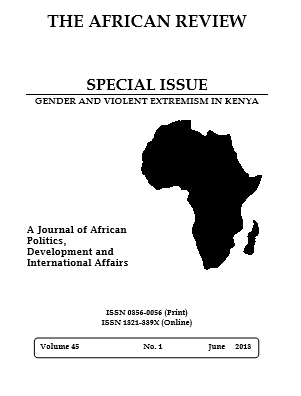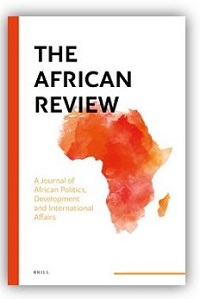Analytical Framing of Violent Extremism and Gender in Kenya: A Review of the Literature
Abstract
Following an examination of the current gaps in the literature on the role of gender and violent extremism (VE) in Kenya, the Royal United Services Institute (RUSI) under the Strengthening Resilience to Violent Extremism (STRIVE) II programme, in partnership with the French Institute for Research in Africa (IFRA), supported the development of four academic studies exploring regional dynamics of women ' s involvement in violent extremist activity. This article, which serves as an introductory note to this Special Issue, situates the four studies in the existing literature and explores their contribution to the understanding of the role and impact of women in violent extremism. In particular, the review argues that the four pieces of research contribute to an area of study that has been missing in much of the published work on women ' s recruitment into VE groups in East Africa. Specifically, the review is premised on the need for examining women ' s recruitment in VE through a gendered lens that interrogates the norms that construct and compel their recruitment and participation and the differential impact of VE on their lives.
Keywords: Violent Extremism, Women, Gender, Role, Recruitment
Gayatri Saghal
Research Manager, Royal United Services Institute for Defence and Security Studies, E-mail: GayatriS@rusi.org
Martine Zeuthen
Team Leader, Royal United Services Institute for Defence and Security Studies E-mail: MartineZ@rusi.org
References
ACLED. (2017, October 9). Al Shabaab and Boko Haram: Patterns of Violence.
Retrieved from ACLED: http://www.crisis.acleddata.com/al-shabaaband-boko-haram-patterns-of-violence/
Ali, A. (2016). Islamist Extremism in East Africa. Africa Security Brief; 32, 1-8.
Balasubramaniym, R. a. (2015). Evolving Role of Women. Journal of Women's Studies 15(2), 197-211.
BBC. (2016, September 11). Kenya Kills Three Women Attackers of Mombasa Police Station. Mombasa , Mombasa, Kenya.
Bloom, M. (2011 ). Bombshell: Women and Terrorism. Gender Issues 28(1-2), 5-13.
Bloom, M., and Matfes, H. (2016). Women as Symbols and Swords in Boko Haram ' s Terror. PRISM, 6(1), 104-121.
Botha, A. (2014). Political Socialization and Terrorist Radicalization Among Individuals Who Joined al-Shabaab in Kenya. Studies in Conflict and Terrorism, 37.
Bryden, M. (2015). The Decline and Fall of Al Shabaab, Think Again. Nairobi:SAHAN.
Carter, B. (2013). Women and Violent Extremism: A literature Review . GSDRC.
d ' Estaing, S. G. (2017). "Engaging Women in Countering Violent Extremism:Avoiding Instrumentalisation and Furthering Agency. Gender and Development 25(1), 103-118.
Dalgaard-Nielsen, A. (2010). Violent Radicalisation in Europe: What We Know and What We Do Not Know. Studies in Conflict and Terrorism.
Denoeux, G., and Carter, L. (2009). Guide to Drivers of Violent Extremism. USAID.
Felter, C., Masters, J., and Sergie, M. A. (2018, March 15). Al-Shabab. Retrieved from Council on Foreign Relations:
https://www.cfr.org/backgrounder/al-shabab
Gardner, J., and Bushra, J. (2016). The impact of war on Somali men and its effects on the family, women and children. Nairobi: Rift Valley Institute Briefing Paper .
Gardner, J., Bushra, J., and ed. (2004). Somalia €“ The Untold Story: The War through the Eyes of Somali Women. London: Pluto Press.
Hansen, S. J. (2013). Al Shabaab in Somalia €“ the History and Ideology of a Militant Islamist Group 2005-2012. London: Oxford University Press.
Harmon, C., and Holmers-Eber, P. (2014). Women in Terrorist Undergrounds.
CTX 4(4), 9.
Horgan, J. (2009). Walking away from Terrorism: Accounts of disengagement from radical and extremist groups. London: Routledge.
Hoyle, C., Bradford, A., and Frenett, R. (2015). Becoming Mulan? Female Western Migrants to ISIS. Institute for Strategic Dialogue.
Human Rights Watch. (2014, October 27). "Those Terrible Weeks in Their Camp": Boko Haram Violence against Women and Girls in Northeast Nigeria. Retrieved from Human Rights Watch:
Human Rights Watch. (2016, April 5). Iraq: Women Suffer Under ISIS. Retrieved from Human Rights Watch:
https://www.hrw.org/news/2016/04/05/iraq-women-suffer-under-isis
Human Rights Watch. (2016, December 5th). Nigeria: Women and the Boko Haram Insurgency. Retrieved from Human Rights Watch:
https://www.crisisgroup.org/africa/west-africa/nigeria/nigeria-womenand-boko-haram-insurgency
ICG. (2016). Nigeria: Women and the Boko Haram Insurgency. Report n ° 242,ICG.
International Crisis Group. (2014). Kenya: Al Shabaab - Closer to Home. Brussels, Beligum : Technical Report 102, International Crisis Group.
Jacques, K., and Taylor, P. (2013). Myths and Realities of Female Perpetrated Terrorism. Law and Human Behaviour, 37(1), 9.
Khalil, J. (2017). The Three Pathways (3P) Model of Violent Extremism - A Framework to Guide Policymakers to the Right Questions about their Preventive Countermeasures. RUSI Journal.
Khalil, J., and Zeuthen, M. (2016). Countering Violent Extremism: A Guide to Programme Design and Evaluation. Whitehall Report-216, 1-36.
Menkhaus, K. (2014). Al Shabaab and Social Media: A Double Edged Sword. ASA 2014 Annual Meeting Paper. SSRN. Retrieved from ASA 2014 Annual Meeting Paper: https://ssrn.com/abstract=2414763
Naureen Chowdhury Fink, S. Z., and ed. (2016). A Man's World? Exploring the Roles of Women in Countering Terrorism and Violent Extremism. Hedayah and The Global Center on Cooperative Security.
Ndungu, I., Salifu, U., and Sigsworth, R. (2017). Violent Extremism in Kenya: Why Women are a Priority. ISS Monograph 197.
Noor, H. M. (2015, October 19th ). Patriarchy, Extremism and Why We Can't Ignore Women. Retrieved from Allafrica:
http://allafrica.com/stories/201510281193.html
O'Rourke, L. A. (2009). What ' s Special About Female Suicide Terrorism? Security Studies, 18, 681-718.
Romaniuk, P. (2016). Summary Report: Rigorous Literature Review of the Drivers of Radicalisation and Extremism in East Africa . Washington: Global Centre on Cooperative Security.
Saltman, E., and Smith, M. (2015). Till Martyrdom Do Us Part: Gender and the ISIS Phenomenon. Institute for Strategic Dialogue.
Sjoberg, L. (2017). Johadi Brides and Female Volunteers: Reading the Islamic State War to see Gender Agency in Conflict Dyanamics . Conflict Management and Peace Science: Special Issue Gender Participation , Well Being and Representations in Political Violence , 1-16.
Sjoberg, L., and Wood, R. (2015). People, Not Pawns: Women's Participation in Violent Extremist Groups . Research Brief USAID.
Spencer, A. (2016). The Hidden Face of Terrorism: An Analysis of Women in the Islamic State. Journal of Strategic Security, 3(9), 74-98.
UNDP. (2017). Journey to Extremism in Africa: Drivers, Incentives and Tipping Point for Recruitment. UNDP.
USAID. (2011). The Development Response To Violent Extremism And Insurgency. Putting Principles into Practice . USAID.
Winterbotham, E., and Pearson, E. (2016). Different Cities, Shared Stories. The RUSI Journal 161(5), 54-65.
Zeuthen, M. (forthcoming year???). Violent Extremism in East Africa. Hedayah.
Downloads
Published
Issue
Section
License
Copyright © by Department of Political Science and Public Administration, University of Dar es Salaam
All rights reserved. No part of this publication may be reproduced or transmitted in any form or by any means, electronic or mechanical, including photocopying, recording, or any information storage or retrieval system, without permission in writing from the publisher, except for short extracts in fair dealing, for research or private study, critical scholarly review or discourse with an acknowledgement.
The African Review: A Journal of African Politics, Development and International Affairs [ISSN 0856-0056 (Print) & ISSN 1821-889X (Online)] is published bi-annually, June and December by the Department of Political Science and Public Administration, University of Dar es Salaam, P.O. Box 35042 €“ Dar es Salaam €“ Tanzania



